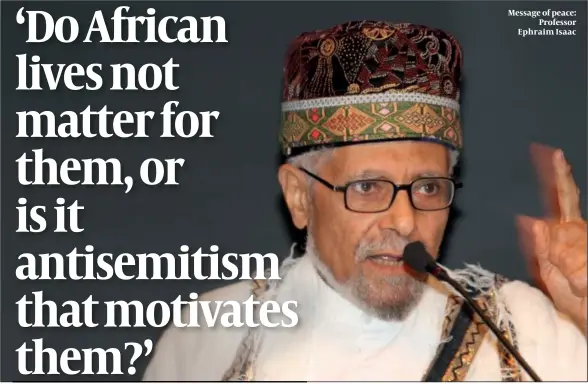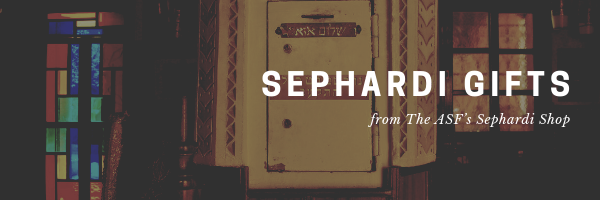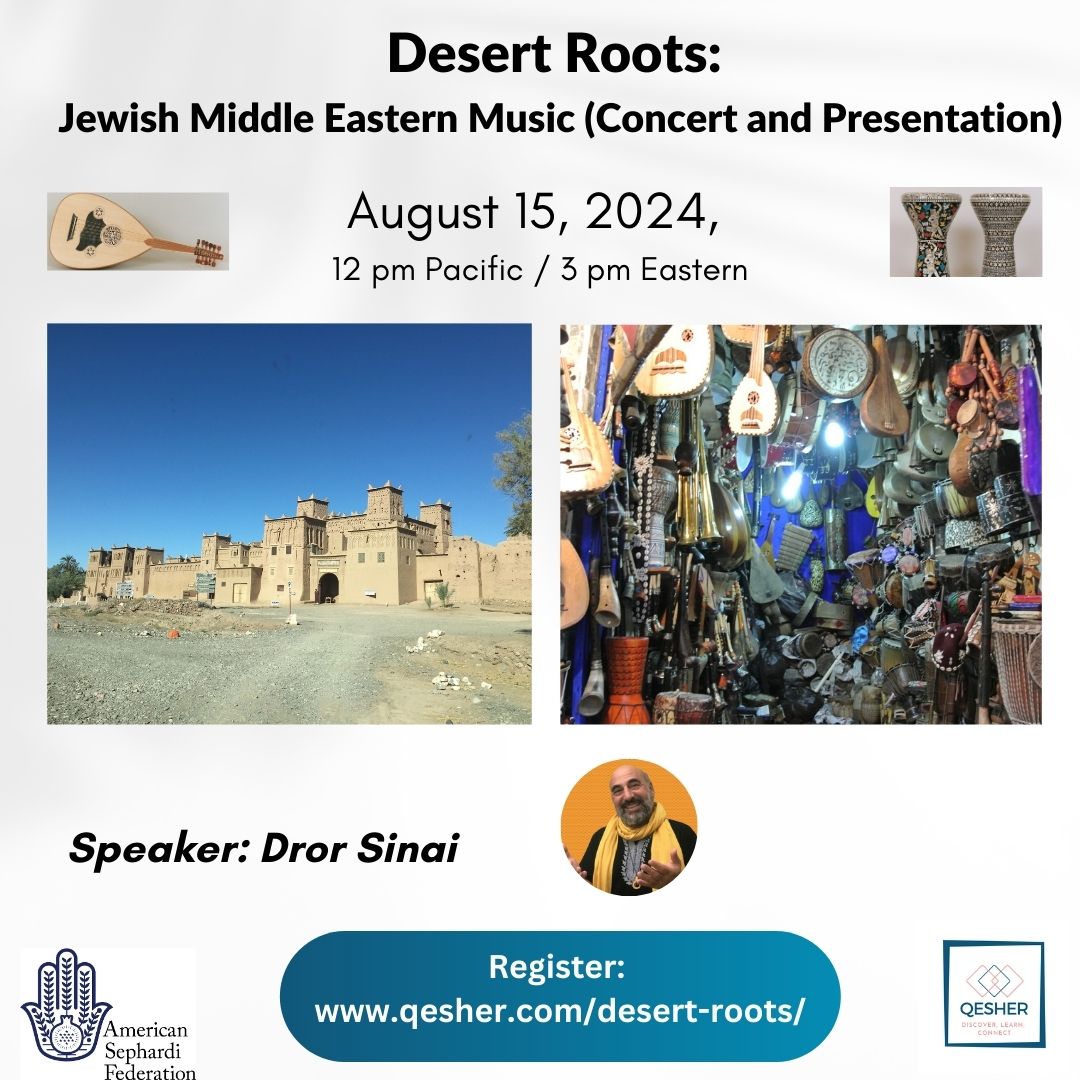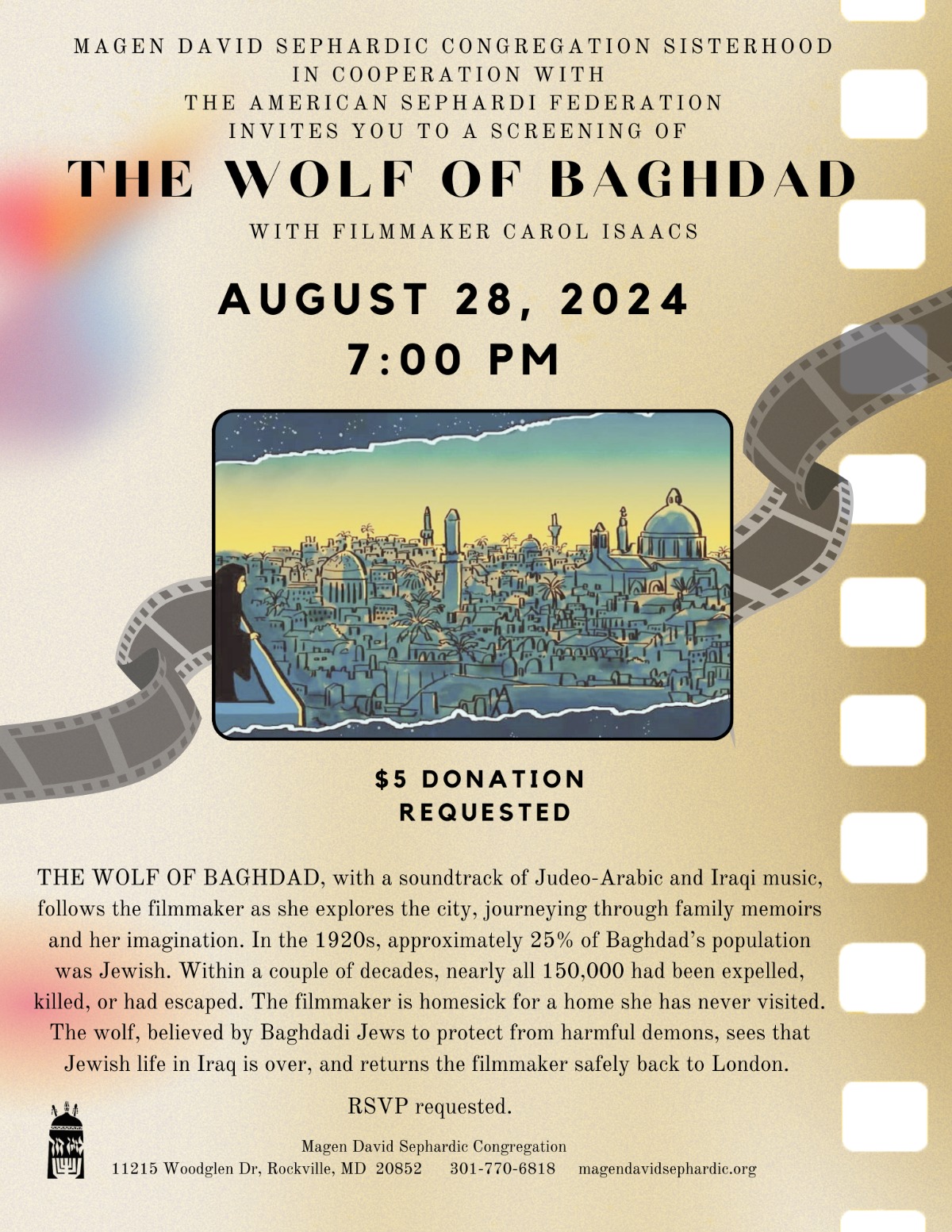Mazal Tov to Isaac Assa, the Mexican-Sephardi Founder and President of Israel + Latin America Network, for the successful launch of the ILAN Foundation in Argentina. He launched honored and featured remarks by Argentine President Javier Milei and his Moroccan Rabbi, now Argentina’s Ambassador to Israel, R’Shimon Axel Wahnish. The ASF was honored to participate in the launch.
Click here to dedicate a future issue in honor or memory of a loved one
Subscribe ◊ Upcoming Events ◊ ASF Sephardi Shop ◊ Donate ◊ Sephardi Ideas Monthly ◊ ASF IJE ◊ ASF Sephardi House ◊ Archive
The Sephardi World Weekly is made possible by Daniel Yifrach, Rachel Sally, Professor Rifka Cook, Maria Gabriela Borrego Medina, Rachel Amar, Deborah Arellano, & ASF VP Gwen Zuares!
Don't miss the latest Sephardi Ideas Monthly: “Emet ve Emunah: The Secret of the Sassoons’ Success”
~~~~~~~
“US students don’t care about wars that aren’t Gaza says Ethiopian Jewish leader”
By Jonathan Harounoff, The Jewish Chronicle
Professor Ephraim Isaac
(Image courtesy of The Jewish Chronicle)
Professor Ephraim Isaac, an eighty-eight-year-old, Ethiopian-Yemenite-Jewish polyglot pioneer of Afro-American Studies at Harvard University and ASF Board Member, has no patience with recent protests on American campuses. “Sitting in the garden of his Princeton home, donning a hat emblazoned with the words Make America Read Again,” Professor Isaac asks some basic questions:
Where are these demonstrators when millions of Black people die not only in Ethiopia but also in South Sudan and Sudan, Chad, Mozambique, Somalia, Western Myanmar, where armed conflicts are escalating?... Do African lives not matter for them, or is it antisemitism that motivates them?
Regarding Harvard, Professor Isaac thinks that the university began to lose its way under the leadership of Derek Bok, president from 1971-1991. That is when Harvard embarked upon “a hiring binge of administrators” with numerous “vice presidents and assistant vice presidents” diverting funds and attention away from
student scholarship and scholarly research and leaving the university exposed to politicization. But the bottom line, according to Prof. Isaac, remains simple:
Students don’t come to university to protest… They are not soldiers. They should be at these institutions to learn.
“Prof. Ronnie Perelis – Antonio de Montezinos and the Ten Lost Tribes in the New World”
By Nachi Weinstein, Seforim Chatter
“The Ten Lost Tribes in Jewish Consciousness” Podcast
(Image courtesy of the Seforim Podcast)
Nachi Weinstein’s “Seforim Podcast” is focusing on the Ten Lost Tribes of Israel. In particular, the Ten Lost Tribes of Israel, in the Americas. A recent episode features Ronny Perelis, Professor of Sephardic Studies and Director of the Rabbi Arthur Schneier Program for International Affairs at Yeshiva University and the ASF’s Academic Representative to the Center for Jewish History, for a discussion that ranges from the rare book room at the Jewish Theological Seminary to post-1492 Amsterdam and back again to the world of trans-Atlantic trade and colonization. Many stories feature Conversos and Jews trying to make a fortune or start a new life in the Americas. Along the way, Prof. Perelis explores the life of Antonio de Montezinos, aka Aharon HaLevi, a crypto-Jew from Portugal who was arrested by the Inquisition in 1639 and who, upon his release, vowed to God that he would track down the members of the Ten Lost Tribes of Israel that he believed he previously met in the jungles of Ecuador. Menasseh Ben Israel, one of the great rabbis of Amsterdam, was persuaded by HaLevi’s account.
“‘Across So Many Seas’ Brings a Sephardic Jewish Story to Life for Middle Grade Readers”
By Hanna R. Neier, Kveller
(Book cover courtesy of Penguin Random House)
Ruth Behar’s latest novel for middle school readers, Across So Many Seas, spans “over 500 years and four different countries” and was inspired, says Behar:
[by] my Sephardic grandmother, who I called Abuela. She was sent alone from Turkey to Cuba by her parents, bringing along an oud on which she played Sephardic songs that she sung in Ladino. No one in our family knows exactly why they shipped her off across the sea.
To explore the mystery of Sephardi Jewish immigrations, Behar composed her novel on a large canvas:
I decided to look back 500 years to the expulsion of the Jewish people from Spain, and to look forward to what remains of that past in the present.
Behar hopes that, after October 7th, the four different tales that she tells will resonate with young Jewish readers from all backgrounds:
I hope my book can help kids to respond to Jewish hate with an awareness of the resilience of our ancestors and the strength we have today to speak back to antisemitism with knowledge, education and illuminating stories.
~~~~~~~
Tu boca en los cielos: La haketia de Menashe y Alfonso
By Gladys Benaim Bunan
Tu boca en los cielos: La haketia de Menashe y Alfonso illustrates the world of the Jews of Northern Morocco through the usage of Haketia. Haketia-speaking Jews lived in Morocco for nearly 500 years, from the year of the exodus from Spain in 1492 until the 1970s.
Haketia, the well-known form of Judaeo-Spanish spoken by Jews living in the Balkans, Greece, Turkey and Jerusalem is “Ladino Oriental” (eastern Ladino). Haketia may be described by contrast as “Ladino Occidental”. The language is a variety of Spanish that borrows heavily from Judeo-Moroccan Arabic. It evidently also contains a number of words of Hebrew origin and was originally written using Hebrew letters. There is some cultural resemblance between the two Judaeo-Spanish dialect communities, including a rich shared stock of Romanzas (ballads) from medieval Spain, though both words and music often differ in detail (as indeed they do between one Oriental-Sephardic community and another).
By Dr. Hélène Jawhara Piñer, a 2018 ASF Broome & Allen Fellow
In this extraordinary, award-winning and best-selling cookbook now in its 4th imprint, chef and scholar Hélène Jawhara-Piñer combines rich culinary history and Jewish heritage to serve up over fifty culturally significant recipes. Steeped in the history of the Sephardic Jews (Jews of Spain) and their diaspora, these recipes are expertly collected from such diverse sources as medieval cookbooks, Inquisition trials, medical treatises, poems, and literature. Original sources ranging from the thirteenth century onwards and written in Arabic, Spanish, Portuguese, Occitan, Italian, and Hebrew, are here presented in English translation, bearing witness to the culinary diversity of the Sephardim, who brought their cuisine with them and kept it alive wherever they went. Jawhara-Piñer provides enlightening commentary for each recipe, revealing underlying societal issues from anti-Semitism to social order. In addition, the author provides several of her own recipes inspired by her research and academic studies.
Each creation and bite of the dishes herein are guaranteed to transport the reader to the most deeply moving and intriguing aspects of Jewish history. Jawhara-Piñer reminds us that eating is a way to commemorate the past.
~~~~~~~
Upcoming Events or Opportunities
Our friends at Qesher present:
Jews of Burma: The Tribe That Vanished
“This is the story of the Burmese Jewish - a community of Jews mostly arrived from Iraq and India in the heydays of the British Empire - that once flourished but quickly ceased to exist. In its short history, the Burmese Jewish community went through the archetypical Jewish narrative, with inner rifts and the mortal danger from the outside. Its members either immigrated or assimilated, but is there still hope for the revival of Jewish life in this distant South-East Asian country? Being a photo-journalist, I took on the opportunity to photograph the remains of the Jewish presence in Burma today and the quickly vanishing traces of the Jewish presence in Burma’s past.”
Sunday, 4 August at 3:00PM EDT
Sign-up Now!
Tickets: $9-$18
About the speaker:
“My name is Misha Gulko, and I’m a photo-journalist from Brooklyn, New York, born in Odessa, Ukraine. Odessa was once a center of Jewish life in the Russian Empire and later in the USSR. The words ‘Jews’ and ‘Odessa’ were once synonyms. But in the USSR, the Jewish culture was heavily suppressed, and once immigration became possible, most Jews (including our family) fled from the country and my city. The Jewish community rapidly shrank, and so did the feeling of our presence and influence on my city’s life and folklore. That’s why the story of the disappearing Jewish community of Burma felt so close to home.”
~~~~~~~
Our friends at Qesher present:
Desert Roots: Jewish Middle Eastern Music
“Concert and Presentation by Dror Sinai
Dror will take us on a beautiful journey around Yemen, Spain and North Africa from the 10th century until today, through songs of spirit and awe, songs of thanks and songs of love and hope.
Singing and chanting Jewish songs in Hebrew, Arabic and Aramaic, we'll explore the poetry of multicultural attitudes and experiences. We will unveil how these chants inspired and connected Jews from different times and places, but with the same longings and spiritual quests.
Dror will accompany his singing with a variety of percussion instruments including a Doumbek (an hourglass Middle Eastern drum also known as Tabla or Darbuka) Tar, Duff & Bendir (a Mideastern & North African Frame drums) a Riq (Mideastern tambourine), Cajon (box drum) bells, shakers and rattles.
Dror’s personality and energy, his great stories, sense of humour and entertaining delivery will make this a beautiful, exciting and healing journey.
Thursday, 15 August at 3:00PM EDT
Sign-up Now!
Tickets: $9-$18
About the speaker:
Dror Sinai grew up in Israel to a family with origins in Syria, Turkey and Yemen. In this environment, prayers, chants, music and dance were all part of the culture and lifestyle.
From an early age Dror has been playing hand drums, singing and dancing traditional Jewish Middle Eastern music, and today he is an international performer and educator. He received the Gail Rich award for supporting the Arts, and is a founding member of the World Music Committee for the Percussive Arts Society.
Dror has been a featured instructor for Spectra of the Santa Cruz Arts Council, and at clinics during PASIC (Percussive Arts Society International Convention). He has performed on the “Peace Boat” as well as at The World Sacred Music Festival, Fez, Morocco.
He is the Founder of RHYTHM FUSION, Inc. in Santa Cruz, California, and also leads musical and cultural explorations bringing tour groups to Morocco (www.Mugical-Morocco.com)”
~~~~~~~
Magen David Sephardic Congregation Sisterhood in cooperation with the American Sephardi Federation present:
THE WOLF OF BAGHDAD
Film screening with the filmmaker Carol Isaacs
Dror will take us on a beautiful journey around Yemen, Spain and North Africa from the 10th century until today, through songs of spirit and awe, songs of thanks and songs of love and hope.
Singing and chanting Jewish songs in Hebrew, Arabic and Aramaic, we'll explore
Wednesday, 28 August at 7:00PM EDT
Sign-up Now!
RSVP Required
Tickets: $5 Donation
Magen David Sephardic Congregation
11215 Woodglen Dr, Rockville, MD 20852
For questions and more details please call 301-770-6818
The Wolf of Baghdad, with a soundtrack of Judeo-Arabic and Iraqi music, follows the filmmaker as she explores the city, journeying through family memoirs and her imagination. In the 1920s, approximately 25% of Baghdad's population was Jewish. Within a couple of decades, nearly all 150,000 had been expelled, killed, or had escaped. The filmmaker is homesick for a home she has never visited.
The wolf, believed by Baghdadi Jews to protect from harmful demons, sees that Jewish life in Iraq is over, and returns the filmmaker safely back to London.
~~~~~~~
The American Sephardi Federation presents:
“The Golden Age of the Jews of Alandalus” | “La Edad de Oro de los judíos de Alandalús”
On View in the Paul S. And Sylvia Steinberg Great Hall
through August 2024
@ the Center for Jewish History
The Jewish community of Alandalús gave the world extraordinary thinkers like Maimonides, diplomats like Ibn Shaprut, and poets like Ibn Gabirol and Judah Halevi, whose wisdom, works, and accomplishments resonate through the ages. 820 years after his death, the RAMBAM’s contributions to medicine, philosophy, diplomacy, and Jewish law continue to inspire wonder and influence till today. Across the Mediterranean in Fustat (Cairo) about two hundred thousand documents accumulated in the Ben Ezra Synagogue’s Genizah—a room or grave where obsolete sacred documents are respectfully discarded—over the course of nearly a millennium.
The geographical location of Egypt, a natural bridge between the Islamic East and Christian West, made it possible for many of these documents to be of Andalusian origin. This exhibition, curated by the University of Granada Professor José Martínez Delgado, takes us on a journey from the origins of this important community to its exodus and extinction in the XIX century. Although subsequently scattered all over the world, Sepharadim have maintained connections to their past by perpetuating traditions, the Ladino (Judeo-Spanish) language, and exemplifying a seriously Jewish yet cosmopolitan worldview.
~~~~~~~
The American Sephardi Federation presents:
Convergence: Arabic, Hebrew, and Persian Calligraphy in Conversation
Featuring the multilingual art of Ruben Shimonov Convergence creates a visual world where Hebrew, Arabic, and Persian languages interact with, and speak to, one another; a world where stylized letters and words dance together on the page; a world where cultures, religions, communities, and philosophies intersect.
Juxtaposing cognates from these ancient West Asian languages, artist Ruben Shimonov encourages the viewer to explore the deep-rooted connections between these tongues, as well as the multilayered and transnational identity of the artist himself.
On View in the Leon Levy Gallery
through August 2024
@ the Center for Jewish History
~~~~~~~
The American Sephardi Federation and Mimouna Association’s Rebuilding Our Homes Project present:
Re-Creation: Judaica by Moroccan Muslim Artisans
Explore the exhibition of Judeo-Moroccan art, Moroccan Judaica, cultural and religious objects, including Menorot, Mezuzot, Yads, Shabbat Candleholders, Seder Plates, Hallah Covers, and much more.
On View through August 2024
@ the Center for Jewish History
As Moroccan Jewish populations largely left the mellahs (Jewish quarters) in the latter half of the 20th century, there was a danger that not only designs but even the traditional artisanal techniques needed to create them would be lost. Passed down from one artisan to another and perfected over time, these designs and techniques. ranging from vibrant patterns to intricate metalwork and soulful wood carvings, are expressions of Moroccanity and reflect the individual character of each city. The materials and craftsmanship of Rabat are different than Fez, and Essaouira is distinct from both.
Mimouna Association and the American Sephardi Federation’s Rebuilding Our Homes Project, a multi-year USAID-supported New Partnerships Initiative, brought three notable experts-Ms. Zhor Rehihil, Ms. Deborah Koenigsberger Gutierrez, and Ms. Meryem Ghandi to train Moroccan Muslim artisans in the history of Judeo-Moroccan art and guided them in re-creating Moroccan Judaica, which encompasses a diverse array of cultural and religious objects, including Menorot, Mezuzot, Yads, Shabbat Candleholders, Seder Plates, Hallah Covers, and much more.










